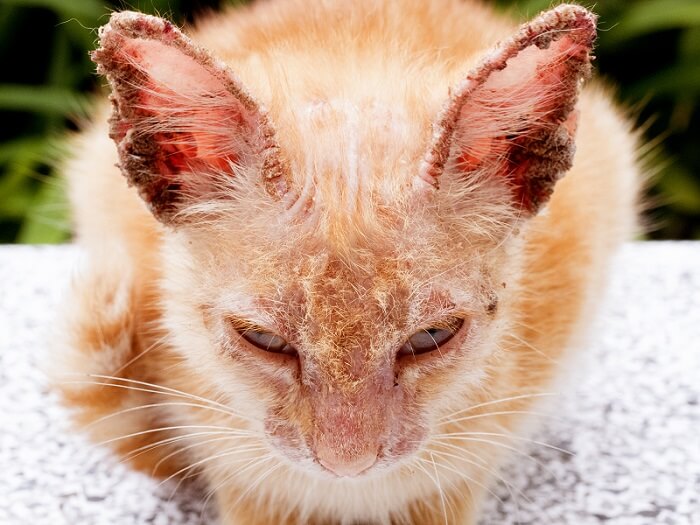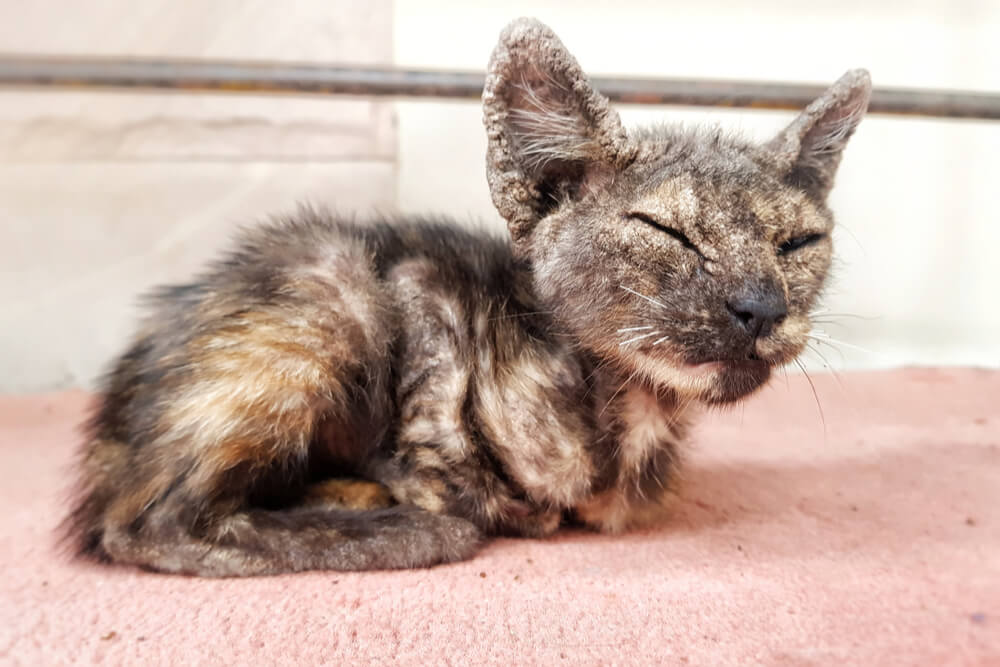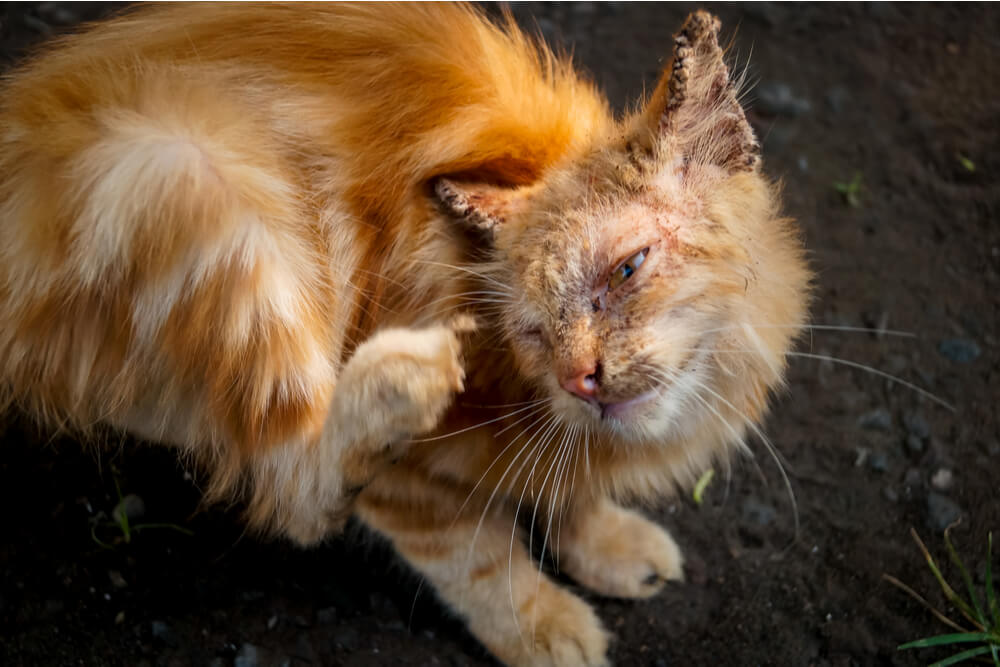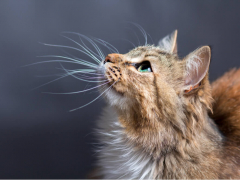
What Is Mange in Cats?
“Mange” is a general term that means an infectious skin disease characterized by intense itching, reddened skin, and alopecia (loss of hair), caused by parasitic mites. While mange is a type of dermatitis (i.e. inflammation of the skin), it is specific in that the underlying cause is specifically identified as infestation with a mange mite.
Many other types of skin disease may resemble mange (i.e. the skin appears reddened, with hair loss) but they require a different diagnostic approach and treatment.
Causes of Mange in Cats

Mange is caused by various types of parasitic mites, including Notoedres cati, Demodex mites, and Sarcoptes scabiei var canis.
There are three parasitic mites that cause different types of mange in cats.
1. Notoedric Mange
Sometimes called “feline scabies”, this is the most common type of mange seen in cats. The condition is caused by a mite called Notoedres cati, which is invisible to the naked eye, measuring 200-250µm in diameter (this is 0.2 to 0.25mm: around the size of a pinprick).
Under the microscope, the mite can be seen as a tiny, oval, white bug with three pairs of short legs on the larvae, and four pairs on the nymph and adult stages. The mite is contagious, spreading from cat to cat by direct contact, causing extreme itchiness as the mites burrow into the skin.
The adult female mites lay the eggs deep in the skin, and after they hatch, the larvae move to the surface of the skin, where they develop into the nymph stage before transforming into adults. All stages of the mite feed on the skin, causing itchiness due to the damage from feeding. The complete life cycle from egg to adult takes three weeks.
Notoedric mange is seen most commonly in cats with a poorer immune system (e.g. kittens). This type of mange is rare in cats: it’s seen in less than 0.1% of cats with skin conditions in the USA and has not been diagnosed in the UK at all for over fifty years.
2. Demodectic Mange
Demodex mites are seen in many mammals (including cats, dogs and humans). They start off as normal, harmless, commensal parasites, living in hair follicles, sebaceous glands, and the superficial layers of the skin.
It’s only when there is some sort of immunodeficiency in the host that the mites start to multiply in large numbers causing skin disease. Demodex mites are cigar shaped, only visible under the microscope, measuring around 350µm or 0.35mm long.
The eggs are also elongated ovals; these hatch into six-legged larvae, which become eight-legged nymphs and then eight-legged adults. Demodectic mange is rare in cats, accounting for less than 0.04% of cases of skin disease in the USA.
3. Sarcoptic Mange
Sarcoptic mange is caused by a mite that normally lives on dogs: Sarcoptes scabiei var canis. This mite is only seen exceptionally rarely in cats, on occasions when they have had close contact with infected dogs or foxes. These mites are small, circular, white mites, slightly larger than Notoedres mites at 300-400µm in diameter (0.3-0.4mm). Again, the larvae have three pairs of legs, while the adult mites have four pairs.
Other external parasites, including ear mites (otodectes cynotis) and walking dandruff (cheyletiella) may resemble these mange mites under the microscope, but they cause a different pattern of ear or skin disease, and are not generally classified as “mange”.
Ringworm may cause balding, reddened areas that resemble mange, but this is caused by a type of fungal infection, so it requires a completely different approach.
Symptoms of Mange in Cats

Itchiness is the primary symptom of mange in cats, along with skin redness, hair loss, dandruff, and more. Symptoms may also vary depending on the type and cause of the mange.
Mange, by definition, causes pruritus (itchiness), with reddened skin and loss of hair in affected areas. Often there is dandruff-like scaling, with crusty build-ups on the cat’s skin. The different mites cause a different pattern of location of affected skin.
- Notoedric mange tends to affect the ears, neck and forelegs.
- Demodectic mange (also known as demodicosis) can be generalised (all over the body) or localised (e.g. around the eyes, head, muzzle or neck with one type of mite, Demodex cati, or along the back, abdomen or limbs with the other type, Demodex gatoi).
- Sarcoptic mange tends to be more generalised, affecting the feet, the sides of the body, the back legs, the face, the ear tips, and the tail
Diagnosis of Mange in Cats
If your cat shows signs of mange, you need to visit your local DVM veterinarian. A sample needs to be collected from the cat (usually a skin scraping, but sometimes an acetate tape impression from the coat can be sufficient to identify Notoedres or Demodex mites).
Examination of the sample under the microscope is always needed to positively identify the causative mite.
Treatment of Mange in Cats
Treatment depends on the type of mite infestation, and the appropriate medication will be prescribed by your veterinarian.
Treatment options include:
- Selamectin as a spot-on topical treatment (a product that owners may be familiar with as a preventive treatment for fleas and heartworm)
- Milbemycin oxime as an oral medication
- Doramectin as a once weekly injection
- Lime sulfur dip as a topical therapy
- Ivermectin as an oral or injectable medication
- Amitraz as a once weekly dip, allowed to dry on the cat without rinsing.
- Moxidectin/imidacloprid (Advocate) as a spot-on topical preparation
- Fluralaner (Bravecto) as an oral medication
- A combination product of fipronil 8.3%, (S)-methoprene 10%, eprinomectin 0.4%, and praziquantel 8.3% (Broadline)
The initial mange problem may be complicated by secondary bacterial infection of the itchy skin, so antibiotics and other treatments for skin infections may also be needed.
All of these products have the potential to be toxic if used incorrectly, so they must only be administered following veterinary prescription and guidance as part of a broad, specific treatment plan.
Frequently Asked Questions
Does apple cider vinegar kill mange?
Despite advice from some websites, apple cider vinegar is unlikely to cure mange in cats on its own, and it’s far more efficacious to use proper miticidal therapy as prescribed by your veterinarian.
Is mange in cats contagious to humans?
Notoedric and demodectic mites are species-specific, so cannot infect humans, while sarcoptic mites may transiently infect humans.
How can I treat my cat for mange at home?
There is no effective home treatment for mange in cats: the only way to effectively resolve this rare problem is to use prescription-only products provided by your veterinarian.







